

Art Zone Interview: Cultural Activism in a Time of Crisis
Author and Curator Susan Platt discusses the art work in Cultural Activism in a Time of Crisis
“Cultural Activism in a Time of Crisis” April 4 – May 6, 2011 M. Rosetta Hunter Gallery, Seattle Central Community College Gallery Hours 9:30-3:30 PM M-F and 5PM – 7PM Tuesday and Wednesday 1701 Broadway Seattle 98122 BE 2116 Contact information at gallery 206 344 4379
The opening featured a short presentation by the curator, Susan Noyes Platt, author of Art and Politics Now, Cultural Activism in a Time of Crisis, (Midmarch 2011) as well as brief remarks by artists who were present. The book is available to buy at Elliott Bay Books and Globe Books in Seattle. All of the work in the exhibition is discussed in the book, as well as the work of 80 other artists from countries around the world.
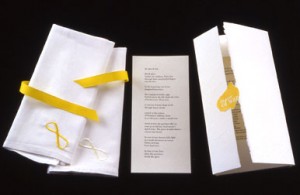
Ellen Sollod and Ginny Hoyle, The Napkin Project. The work was created during the lead up to the U.S. War on Iraq and delivered, by hand or by mail, to 60 people around the world whose actions could foster peace
Art and Politics Now and the exhibition “Cultural Activism in a Time of Crisis” reveals the power that artists have to make a difference when they choose to thoughtfully engage with the concerns of the world.
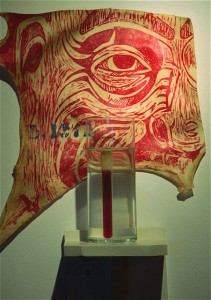
This work by Tanis S'eiltin is one part of her large installation Resisting Acts of Distillation, which addresses the Federal requirement that 25% native blood is required to qualify for tribal rights. The print on rawhide is based on an historical wooden mask of a warrior taken from the Tlingit tribe in the nineteenth century.

La Malinche has been vilified in Mexican history as the betrayer and whore. I maintain in this piece that when one is a slave, one does not have any options. Chicanas have been researching how women are portrayed in Latin American literature and history and how these portrayals justify the normalizing of violence towards women.
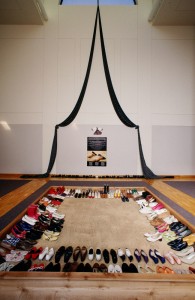
Munoz’s installation includes various garments and bolts of fabric hanging from the ceiling in reference to the women who work at maquilladora factories in Juarez and elsewhere. Her art work includes a memorial altar honoring those who have been murdered. The child’s dress at the center is in this exhibition.
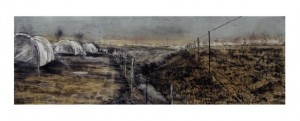
This etching by Kim Berman is part of a series of works in response to the xenophobic riots in Johannesburg in May 2008. The United Nations tents on the left housed thousands of people who were displaced, accused of being aliens. They were primarily from neighboring African countries.
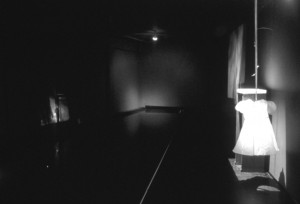
This still from a video by Claudia Bernardi documents an installation that honors the disappeared in Argentina as an excavation, a ritual, and a whispering confession of secrets, fears and hopes.
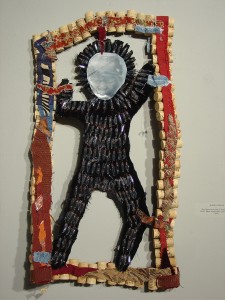
Marita Dingus brilliantly recycles everything from plastic to metal to create figures that suggest both the limitations of life caused by racism, and the possibilities of rejuvenation and liberation.
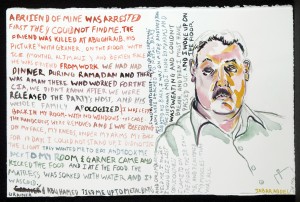
Daniel Heyman joined a legal team to interview the people subjected to torture at Abu Ghraib. His art work includes excerpts from their verbatim descriptions, as well as portraits of individuals who were forcibly detained and later declared innocent.
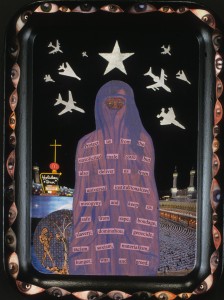
Deborah Lawrence links capitalism to militarism and the exploitation of women. She created these works shortly after the World Trade Center attacks of 2001.
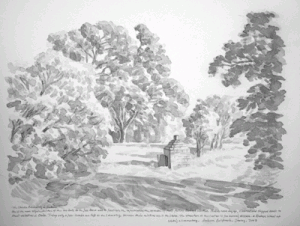
Zhi Lin began his project “Invisible and Unwelcomed People: Chinese Railroad Workers” in 2005. He probes the places and conditions of the Chinese workers brought from China to build the railroads from the California coast to Utah. They worked and often died in miserable conditions. These ink drawings mimic the style of 19th century “romantic” landscape watercolors, the period of oppression for these workers.
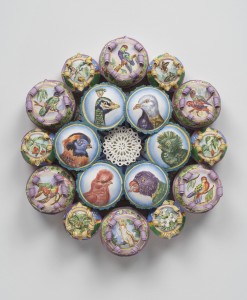
Maki Tamura foregrounds the grotesque images of people, animals, birds, and plants from the seventeenth and eighteenth century “Age of the Enlightenment.” The images are precisely and beautifully rendered, but truncated. Violence is implied: these creatures were hunted, killed, collected, categorized and stuffed throughout the colonial era.
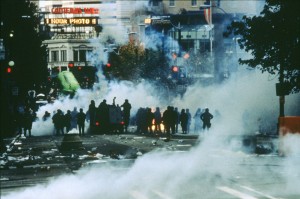
Dean Wong's compelling image is part of a group of photographs that the award- winning photojournalist took of the anti World Trade Organization protests in Seattle in 1999.
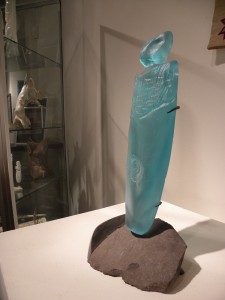
This work is part of an ongoing series of works based on Lillian Pitt’s roots in the ancient cultures of the Columbia River and the possibility that they can provide healing for our troubled world.
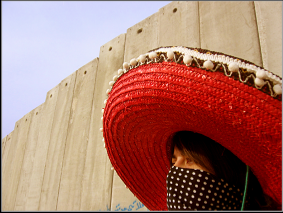
This is a still from a four minute video. Larissa Sansour's videos mimic popular television genres, here the spaghetti Western, to introduce humor into the discourse on the oppressive situation in Bethlehem.
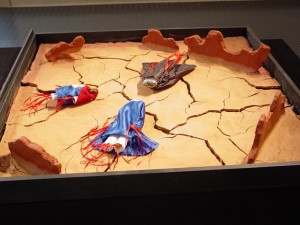
Gail Tremblay created this sculpture in protest of the deaths of civilians in the earliest stages of the war in Afghanistan. It could have been made yesterday.